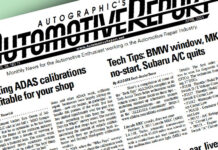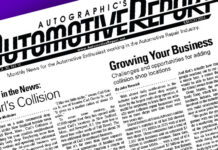News You Can Use But Might Have Missed
By John Yoswick
So much happens in the collision repair industry that it can be hard to keep up on everything. A few big stories get plenty of attention, but sometimes it’s the lesser-known stories that can have just as big an impact on your business.
As another year comes to an end, here are ten news stories from this past year that might have flown under your radar amid the day-to-day challenges of running your shop but that could prove helpful for you to know about.
1. Shops that research OEM procedures are more likely to ask and get paid for “not-included” repair operations, according to the “Who Pays for What?” series of quarterly surveys conducted by Collision Advice and CRASH Network.
While the surveys are primarily designed to explore the payment frequency of “not-included” repair operations, one of the surveys also asked shops how often they research OEM repair procedures at the time they write the estimate. In a nearly perfect correlation, the results showed that shops who said they “always” research OEM procedures were over 20 percent more likely to be paid for not-included repair operations most (if not all) of the time.
Conversely, those shops that said they “never” research OEM procedures were over 80 percent more likely to say they have “never asked” to be paid for those same “not-included” repair procedures.
“Perhaps this speaks more about the attitude a shop takes toward educating themselves and their employees more than any other factor,” industry trainer and consultant Mike Anderson, who designed the survey series, said. “It stands to reason that those who take the time to research the proper repair procedures also take the time to learn how they should be properly reimbursed for the extra effort it takes to do the job right — which is what these survey results are designed to help them with.”
Shops can sign up to take one of the surveys — those that do receive that survey’s results for free — or get more information on complete survey results at www.crashnetwork.com/collisionadvice.
2. The average collision claim rose to $3,160 in 2014 from $3,144 in 2013, marking the fourth consecutive year of increasing severity for private passenger auto insurers. But the rate of growth slowed considerably, and severity still has not rebounded to pre-recession levels.
The rate of increase from 2013 to 2014 was just 0.51 percent; in the prior three years, the annual increase averaged 4.2 percent, more than eight times faster growth.
After having peaked at $3,194 in 2006, the average collision claim began a four-year descent, eventually falling $416 (13 percent) to just $2,778 in 2010. Since then, average severity has risen over the past four years but is still $34 dollars short of the all-time high recorded in 2006.
The data, published by the Insurance Information Institute, also shows that the average severity for comprehensive claims (which can include deer hits, hail damage, etc.) fell 3.3 percent in 2014, halting a four-year rise that saw the average comprehensive claim increase by 16.7 percent since the low in 2009. At $1,567 in 2014, the average comprehensive claim is still higher than the pre-recession peak of $1,551 reached in 2008.
Although both severity measures have risen fairly quickly over the past several years, the average annual increase over the past 10 years, from 2004 to 2014, is still just 1.06 percent for comprehensive claims (about a $16 per year increase), and collision claims have remained practically flat over the past 10 years — increasing, on average, just 0.26 percent annually. That’s an annual rise of only $8, a little more than the price of a cup of paint.
3. Employers in the automotive aftermarket can post job openings on a new national online job board (http://jobs.autocarecareers.org/) created by the Auto Care Association. More than 250 such jobs were posted since the site went live in mid-August.
4. Despite some predictions that driving levels in the United States might not ever rebound to pre-recession levels, Federal Highway Administration numbers show a record high 1.54 trillion vehicle miles traveled in the first half of 2015, slightly higher than the previous record of 1.5 trillion in the first half of 2007. June driving numbers were the highest ever recorded for that month. Among states, Hawaii (up 10.8 percent), Colorado (up 7.8 percent) and Montana (up 7.5 percent) saw the biggest gains, while the nine-state Northeast region (Pennsylvania to Maine) saw the smallest increase in driving (up 1.1 percent).
5. Allstate has been issued a patent proposing to use sensors, cameras and other devices to monitor just about everything going on in a vehicle, from seat position and stereo volume, to the number and ages of occupants and potential sources of driver distraction. The patent discusses a broad set of data the insurer would like to gather, including the driver’s phone use and eating habits while driving, any alcohol content in the air, and even the driver’s eyeline, head position, heart rate and blood pressure.
The patent, called “traffic-based driving analysis,” even envisions gathering information on nearby vehicles so the carrier can compare its policyholders’ habits to other drivers in the area.
“So my car spies on me and on other drivers near me?” said Bob Hunter, insurance director for the Consumer Federation of America and a former Texas insurance commissioner, in an interview with the Chicago Tribune after reviewing the patent. “Even if I give permission for this intrusive technology, my car spies on unsuspecting passengers and even on unsuspecting pedestrians or cars passing by?”
The patent, which Allstate said it filed a few years ago, comes just a few months after Allstate CEO Tom Wilson suggested that Allstate could potentially sell as an “additional profit source” the data it is collecting from drivers using its “DriveWise” or “DriveSense” monitors.
And it follows Allstate claims executive Clint Marlow last summer saying that information about an accident gleaned from a vehicle’s own systems, coupled with historic claims data, could potentially reduce the need for the traditional estimating process.
“How many Ford F-150s hit in the left front with a certain velocity do we need to fix before we can get to a decent confidence level to predict that loss cost up front, and allow you guys to do what you do best: fix the car,” Marlow said.
6. If OSHA asked you for evidence that your painter’s spraysuit offers adequate protection from isocyanates — something that is your responsibility as an employer —could you provide it? Whether or not test results are available from the manufacturer of that spraysuit likely depends on which brand you’ve chosen. Even some big-name manufacturers of spraysuits have failed to provide documentation of testing of their suits.
At the Collision Industry Conference (CIC) in Detroit last summer, Brandon Thomas of GMG Envirosafe said only some of the ten spraysuit manufacturers he had been in contact with over seven months had been able to show documentation that their spraysuits have passed a standardized test (ASTM F903) for resistance to penetration of liquids.
“The others either failed the test or they declined to provide the results or comment,” Thomas said.
CRASH Network followed up with the manufacturers, receiving documentation of successful testing from five: 3M, Coverco, Devilbiss, EZ Mix and SAS Safety Corp. (Thomas cautions that many manufacturers offer several lines of spraysuits, so test results for one line do not mean all of that manufacturers’ suits have passed.)
DuPont told CRASH Network in August that it was “still testing our portfolio.”
Summit Group, which manufactures branded suits for AkzoNobel, said it expected to have test results later this year. Canada-based Choko Design, which manufacturers branded suits for Sata and Sherwin-Williams, told CRASH Network that its suits have previously passed lab testing (though the company did not supply documentation) and said it is having additional testing done.
Two other spraysuit manufacturers, Shoot Suit and CTW International, failed to respond to repeated requests for information.
CRASH Network (www.CrashNetwork.com) has published a table with links to the test results provided by the manufacturers.
“There are manufacturers out there that do not think the type of testing that we went through is even needed to protect the health and safety of the workers,” Thomas said. “I’m not disputing that in any way, shape or form. I just think it’s important that we draw these issues to the surface, and ultimately it’s now up to shop owners … to decide whether to carry it from there.”
8. There are “real questions as to whether there will even be an auto insurance industry as we know it in 20 years,” according to an analyst note from Deutsche Bank reported by Business Insider last summer. The report says the Wall Street firm sees the concurrent rise in ride-sharing services and autonomous vehicles as driving three key changes that may be the ultimate downfall of the auto insurance industry.
First, accident frequency will decline to where it will be difficult to charge a meaningful premium for insurance.
Second, insurance will take the form of commercial product liability instead of personal driver liability as consumers let the cars do the driving.
And third, vehicle utilization will rise as one car can serve the driving needs of multiple travelers per day, in-turn resulting in fewer cars on the road.
The analysis, which came with a downgraded rating on Progressive Insurance stock, noted that Progressive is particularly exposed as its policyholders tend to be young people more likely to adopt new technologies.
Business Insider highlighted the analyst’s note that auto insurers could adapt to these changes, but there is a possibility that firms such as Progressive “may find its products completely unnecessary in 2030.”
9. IHS Automotive believes that the volume of vehicles on U.S. roads that are five years old or newer will increase by 24 percent over the next five years. That should be good news for collision repairers because newer vehicles are less likely to be totaled and more likely to be insured and repaired.
The prediction is based on the growth of new vehicle registrations in the past few years as the U.S. auto industry has rebounded.
IHS Automotive also said that the average age for both passenger cars and light trucks on the road has risen once again to 11.5 years, but that the rate of aging will slow in the coming years. Looking ahead, IHS forecasts that average age is likely to hit 11.6 years in 2016 but not reach 11.7 until 2018.
The rate of growth is slowing from what it was 2008–2013 because of the recovery in new vehicle sales. But the overall fleet continues to age because cars are built to last longer and are being driven longer before they are scrapped.
10. The Automotive Service Association (ASA) this year updated its “not-included operations” charts (http://tinyurl.com/ASAcharts). Dan Risley of the ASA said the free guide is designed to help “the estimator accurately document all the necessary labor operations for the three major estimating systems.” •
John Yoswick, a freelance writer based in Portland, Ore., who has been writing about the automotive industry since 1988, is also the editor of the weekly CRASH Network (for a free 4-week trial subscription, visit www.CrashNetwork.com). He can be contacted by email at jyoswick@SpiritOne.com.



